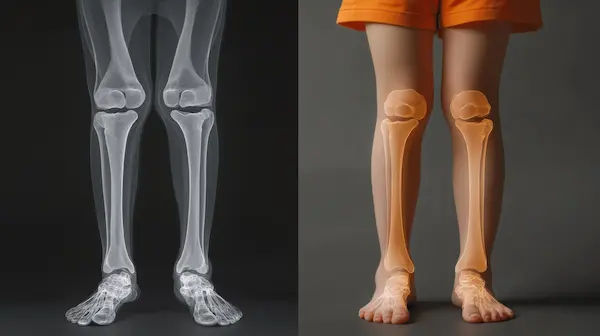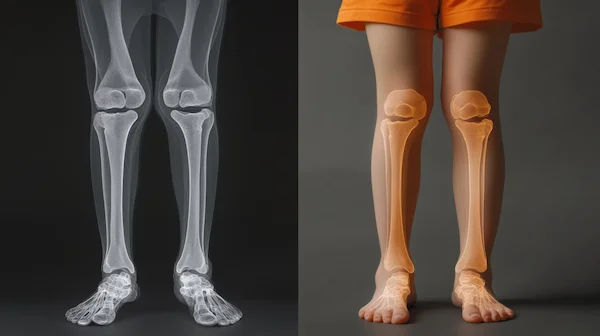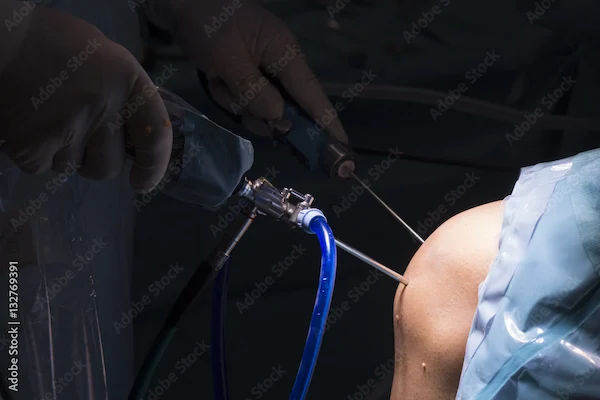Guide to Genu Valgum Another Name Knock Knees What Treatment
Know about the knock knees, causes, signs, symptoms, observation to surgery, diagnosis and more.

Written by Dr. Rohinipriyanka Pondugula
Reviewed by Dr. Shaik Abdul Kalam MD (Physician)
Last updated on 23rd Sep, 2025

Introduction
Have you noticed your child standing with their knees touching but their ankles far apart? This common postural trait, known as knock knees or by its medical name, genu valgum, is a frequent source of parental concern. In most young children, it's a perfectly normal stage of leg development that corrects itself over time. But when is it more than just a phase? This comprehensive guide will walk you through everything you need to know about genu valgum. We'll explore its causes, differentiate between normal and problematic cases, and detail the range of treatment options—from simple observation to physical therapy and surgery. Understanding the facts will help you decide when to practice patience and when it might be time to consult a doctor.
What Exactly Are Knock Knees? Understanding Genu Valgum
Knock knees are a condition where the knees angle inward and touch each other when the legs are straightened, while the ankles remain separated. This creates a noticeable gap between the feet. It's a type of knee misalignment that affects the way forces are distributed through the joints of the leg during walking and running.
Consult an Orthopaedic for Personalised Advice
The Medical Terminology: Genu Valgum Meaning
The term "genu valgum" comes from Latin: "genu" means knee, and "valgum" means bent outward. This might seem confusing—if the knees are knocking inward, why "outward"? The term actually describes the position of the lower leg bone (the tibia) in relation to the thigh bone (the femur). In this condition, the tibia is angled away from the body's midline, which forces the knees inward.
How Knock Knees Differ from Bow Legs (Genu Varum)
Knock knees are essentially the opposite of bow legs, which is medically termed genu varum. In bow legs, the knees stay wide apart when the ankles are together, creating a curved "bow" shape. It's common for children to go through a bow-legged phase as toddlers (often until age 2-3) and then transition into a knock-kneed phase (peaking around ages 3-5) before their legs finally straighten to their adult alignment around age 7 or 8.
---
What Causes Knock Knees? From Normal Development to Underlying Conditions
Understanding the root cause is essential for determining the right course of action. Causes are broadly categorised as physiological (normal) or pathological (due to an underlying disease or condition).
Physiological Genu Valgum: The Normal Childhood Phase
The vast majority of knock-knee cases in children between the ages of 2 and 6 are physiological. This is a natural part of skeletal growth and development. As a child grows, their bones undergo subtle changes in alignment. This phase typically peaks around age 4, and the legs gradually straighten on their own without any intervention. By age 7-8, most children have achieved normal leg alignment.
Pathological Causes in Children
When knock knees are severe, appear outside the typical age range, are asymmetric (one leg worse than the other), or are accompanied by pain, they may be pathological. Common causes include:
Nutritional Deficiencies: Rickets
Rickets, a disease caused by a severe deficiency of Vitamin D or calcium, leads to soft, weak bones. As the bones grow, they can't support the body's weight properly, resulting in bending deformities, including knock knees. With improved nutrition, rickets is less common but still occurs. Apollo24|7 offers convenient home collection for tests like vitamin D levels, which can help rule out this deficiency.
Genetic and Skeletal Conditions
Certain genetic conditions, like skeletal dysplasias or metabolic bone diseases, can affect bone growth and lead to misalignment.
Obesity and Its Impact
Excess body weight places increased stress on a child's developing legs and knees, which can exacerbate knock knees or prevent them from self-correcting.
Causes of Knock Knees in Adults
While less common, adults can develop knock knees. This is usually due to:
- An untreated childhood condition that never resolved.
- Arthritis, particularly rheumatoid arthritis, can destroy knee joint cartilage and alter alignment.
- A traumatic injury to the growth plate near the knee during adolescence.
- Osteoarthritis leads to wear on the outer side of the knee.
Recognising the Signs: Symptoms of Knock Knees
The signs and symptoms include:
The Visual Appearance and Gait
The primary sign is the visible gap between the ankles while the knees are together. Parents might also notice an awkward gait, where the child swings their legs outward or crosses one foot in front of the other to avoid hitting their knees together while walking. Some children may trip more frequently.
When Knock Knees Cause Pain and Functional Issues
Physiological knock knees are usually painless. However, in persistent or severe cases, symptoms may include:
- Knee, hip, or ankle pain due to the abnormal stress on the joints.
- Limping while walking or running.
- Reduced activity or reluctance to participate in sports.
- Knee instability or a feeling of the knee "giving way."
If symptoms like pain or limping persist beyond two weeks, consult a doctor online with Apollo24|7 for further
evaluation.
How Are Knock Knees Diagnosed?
The Physical Examination and Medical History
A doctor will start by taking a detailed history, including the child's age, when the knock knees were first noticed, and any family history. During the physical exam, they will observe the child standing and walking. They will also measure the intermalleolar distance—the gap between the inner ankles when the knees are touching. A distance of up to 8-10 cm can be normal in a 4-year-old but is considered abnormal in an older child or adult.
The Role of X-rays and Measuring the Q-Angle
If the doctor suspects a pathological cause, they will order X-rays. These images allow them to visualise the bones, measure the precise angle of deformity (the Q-angle or tibiofemoral angle), and assess the growth plates. X-rays are crucial for planning surgery if it becomes necessary.
Knock Knees Treatment: From Observation to Surgery
Treatment is entirely dependent on the cause, the child's age, and the severity of the condition.
The "Wait-and-See" Approach for Children
For physiological genu valgum in a young child, the standard treatment is observation. No braces, special shoes, or exercises are needed. The doctor will simply monitor the child's alignment during regular check-ups to ensure it's
improving with time.
Non-Surgical Interventions
Physical Therapy and Exercises for Knock Knees
PT cannot change the bone alignment, but it can be highly effective in strengthening the hip and leg muscles (especially glutes and abductors). This improves stability, corrects gait patterns, and can alleviate pain by providing better support to the joints. Exercises like clamshells, lateral leg raises, and hip bridges are often prescribed.
The (Limited) Role of Braces and Orthotics
Braces, splints, or special orthotic shoe inserts were once commonly used but are now rarely recommended for
physiological cases. Research has shown they are ineffective and can cause emotional distress and physical problems for the child. They may have a very limited role in specific metabolic diseases under strict medical supervision.
Surgical Treatment Options
Surgery is only considered if the deformity is severe, causing significant pain or functional limitations, and hasn't improved by late childhood (around age 10).
Guided Growth Surgery (Minimally Invasive)
This is the most common procedure for children who are still growing. A small metal plate or screw (known as a
tension band plate) is placed on the inner side of the growth plate at the knee. This temporarily tethers the growth on that side, allowing the outer side to continue growing and gradually straighten the leg over 6-18 months. The plate is then removed in a minor procedure.
Osteotomy for Adults and Severe Cases
For adults or children who have stopped growing, an osteotomy is performed. This involves making a precise cut in the bone (either the femur or tibia) and reshaping it to correct the alignment. The bone is held in place with plates and screws until it heals. This is a more significant surgery with a longer recovery period.
Conclusion
In summary, genu valgum, or knock knees, is most often a transient and harmless phase of childhood growth. While it can be alarming to see your child's legs appear misaligned, understanding that it's typically a self-resolving condition can provide significant peace of mind. The key is vigilant observation—celebrating normal development while being aware of the red flags that warrant a professional opinion. The goal is always to ensure a pain-free, functional, and active life. If your child’s condition does not improve after age 8 or is causing consistent pain, book a physical visit to a doctor with Apollo24|7 for a thorough evaluation and personalised care plan.
Consult an Orthopaedic for Personalised Advice
Consult an Orthopaedic for Personalised Advice

Dr. Manoj Dinkar
Orthopaedician
15 Years • MBBS, Dip (Orthopaedics)
New Delhi
THE DOCTORS NESST, New Delhi

Dr. Padam Singh Gautam
General Physician/ Internal Medicine Specialist
43 Years • M.B.B.S (WARDHA M. S.), F.A.G.E. (MANIPAL), F.A.I.M.S. (Pb.), M.A.I.M.S. (Pb.), M.R.S.H. (LONDON)
Noida
Dr Padam Singh Gautam Fracture Clinic, Noida
(225+ Patients)
Dr. Anil Sharma
Orthopaedician
42 Years • MBBS, MS Orthopedics
New Delhi
AAKASH MEDSQUARE, New Delhi

Dr. Susheel B
Orthopaedician
13 Years • MBBS, MS, Ortho Fellowship in Trauma ( Germany) Fellowship in Arthroscopy and Arthroplasty ( Switzerland)
Bengaluru
Apollo Medical Center, Marathahalli, Bengaluru

Dr. Anil Pradeep Jadhav
Orthopaedician
23 Years • MBBS MS (Ortho)
Nashik
Apollo Hospitals Nashik, Nashik
(25+ Patients)
Consult an Orthopaedic for Personalised Advice

Dr. Manoj Dinkar
Orthopaedician
15 Years • MBBS, Dip (Orthopaedics)
New Delhi
THE DOCTORS NESST, New Delhi

Dr. Padam Singh Gautam
General Physician/ Internal Medicine Specialist
43 Years • M.B.B.S (WARDHA M. S.), F.A.G.E. (MANIPAL), F.A.I.M.S. (Pb.), M.A.I.M.S. (Pb.), M.R.S.H. (LONDON)
Noida
Dr Padam Singh Gautam Fracture Clinic, Noida
(225+ Patients)
Dr. Anil Sharma
Orthopaedician
42 Years • MBBS, MS Orthopedics
New Delhi
AAKASH MEDSQUARE, New Delhi

Dr. Susheel B
Orthopaedician
13 Years • MBBS, MS, Ortho Fellowship in Trauma ( Germany) Fellowship in Arthroscopy and Arthroplasty ( Switzerland)
Bengaluru
Apollo Medical Center, Marathahalli, Bengaluru

Dr. Anil Pradeep Jadhav
Orthopaedician
23 Years • MBBS MS (Ortho)
Nashik
Apollo Hospitals Nashik, Nashik
(25+ Patients)
More articles from Knock Knees
Frequently Asked Questions
1. Can adults fix knock knees without surgery?
In adults, the bones have stopped growing, so non-surgical methods cannot change the bone alignment. However, physical therapy to strengthen supporting muscles can significantly reduce pain, improve function, and delay the progression of arthritis. Surgery (osteotomy) is the only way to correct the bony alignment in adults.
2. What exercises are good for knock knees?
.Focus on strengthening the hip abductors and external rotators. Excellent exercises to correct muscle imbalances include:
- Clamshells
- Lateral leg raises
- Hip bridges
- Banded squats, focusing on pushing the knees outward
- A physical therapist can create a personalised exercise plan.
3. At what age should knock knees disappear?
A.Physiological knock knees typically begin to improve around age 5-6 and should be mostly resolved by age 7-8. If significant knock knees persist beyond age 8, it is recommended to have them evaluated by an orthopaedic specialist.
4. Is having knock knees genetic?
The tendency for physiological knock knees can run in families. However, specific pathological causes like rickets or genetic skeletal dysplasias can also be inherited. If you have a strong family history of severe leg deformities, mentioning this to your doctor is important.
5. Can knock knees cause arthritis?
Yes, severe, untreated knock knees can alter the mechanics of the knee joint, placing excessive stress on the outer compartment. Over many decades, this abnormal wear and tear can increase the risk of developing osteoarthritis and knee pain later in life. Correcting the alignment aims to prevent this.



